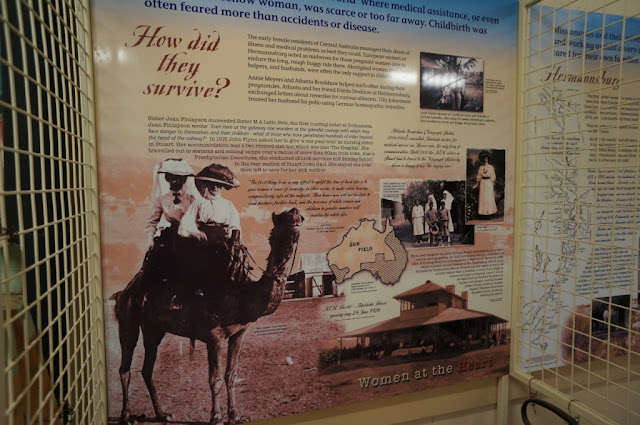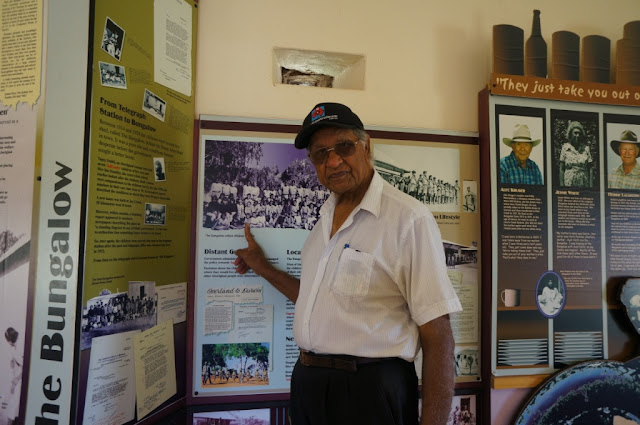Every two weeks, there is a fabulous outdoor market on the Todd Mall. Stalls with mouthwatering food and locally made goods make for a terrific outing. The fact the sun was shining and the weather was warm only added to the experience.
 |
| Todd Mall Market on a beautiful "Fall" day |
Alice Springs is smack dab in the middle of Australia and during my walkabout, I got to appreciate the challenges those who live in the Outback experience.
I've been lucky to find a great taxi driver in the Alice, Stanley, and he added to my list by suggesting I start my day at the Telegraph Station. This is where the earliest European settlers came and in 1872 began relaying messages from Darwin to Adelaide.
 |
| The buildings were made of bricks to help keep the houses cooler in the summers where temps reach over 40C |
 |
| Volunteers still send messages to other telegraph stations throughout the country |
 |
| Many of the artifacts from the 1800s have been well maintained |
 |
| A pair of galahs on the property. They can be quite boisterous and Aussies who act silly are often called galahs. |
 |
| A gum tree dating back to the 1800s |
I was walking on my own around the outdoor exhibits when an older gentlemen rolled up in a motorized wheelchair and started chatting with me. He told me his name was Alec Ross, and he had lived at the school in the 30s, which prompted me asking him if he was from the Stolen Generation.
He scoffed and said, "I had a good life, and it was the best thing to have happened." His mother was a 15 year old Aboriginal woman and his father a white Scotsman. Contrary to what happened to other children, Alec's father gave the Methodist church money to keep him in school, and he also kept in contact with Alec who eventually met some of his 11 half-siblings.
School of the Air. Not that far, but it was a hot slog but fortunately most of it was downhill.
The school began in 1951 and now provides distance learning to 130 students over an area that covers more than 1 million square kilometers. To give you some idea - that's double the size of Texas. Originally classes were taught over the radio, but now it is done via webcam.
 |
| The map shows where all the students live and are color coded based on their grade level. Students come to Alice Springs 3-4 times a year for a week of interaction with other students. |
 |
| It's hard to see because of the dark metal and glare from the glass, but this tile has a bullet hole in it and Agnews written on it -- my maiden name. Would love to know more about that family! |
Next stop...The Royal Flying Doctor Service in Alice Springs historic district. It is a vitally important service in Australia and has impressive statistics: 36 aircraft make 40,000 flights in a year, fly more than 16 million kilometers and aerially evacuate some 26,000 patients.
Testimonials of patients that have been saved because of the RFDS reinforced the need due to people living and working in remote locations throughout the country.
Medicine chests are used to help first responders in remote locations. The contents have changed over the years, and the picture below is of one used in 1958. I read that in a medical emergency a few years ago, a rancher was instructed to give the patient a #9 tablet. Later, when the physician followed up, the rancher said, "I didn't have a 9, so I gave her a #5 and and #4 and she turned out alright!"
 |
| Everything is numbered to enable laymen to administer emergency first aid and medical care |
 |
| The black wing icons show all the Royal Flying Doctor Service locations throughout Australia |
Last stop of the day was the National Pioneer Women's Hall of Fame that also included the Gaol and Labour Prison at Alice Springs that ran from 1938 to 1996.
In the fact sheet given, I learned that when the gaol was first opened, it was segregated into male and female and then white and aboriginal. Until the 1950s, Australia had a "White Australia" policy where no person of colour could be naturalized. Aborigines were wards of the state rather than citizens of the country.
Another interesting component was the Pioneer Women's exhibit. Those women were tough. Distances were immense.....weather was extreme....and there were many dangers.
 |
| The photo displays told an incredible story. In this collage, nurses are shown travelling via camels and the caption states that women feared childbirth more than accidents or disease. |
A grand day made even better with Roger emailing to say our Australian visas have been approved for two years.
All I can say is:
"Bonzer! Fair Dinkum! Ripper! She'll be apples!"







1 comment:
Post a Comment